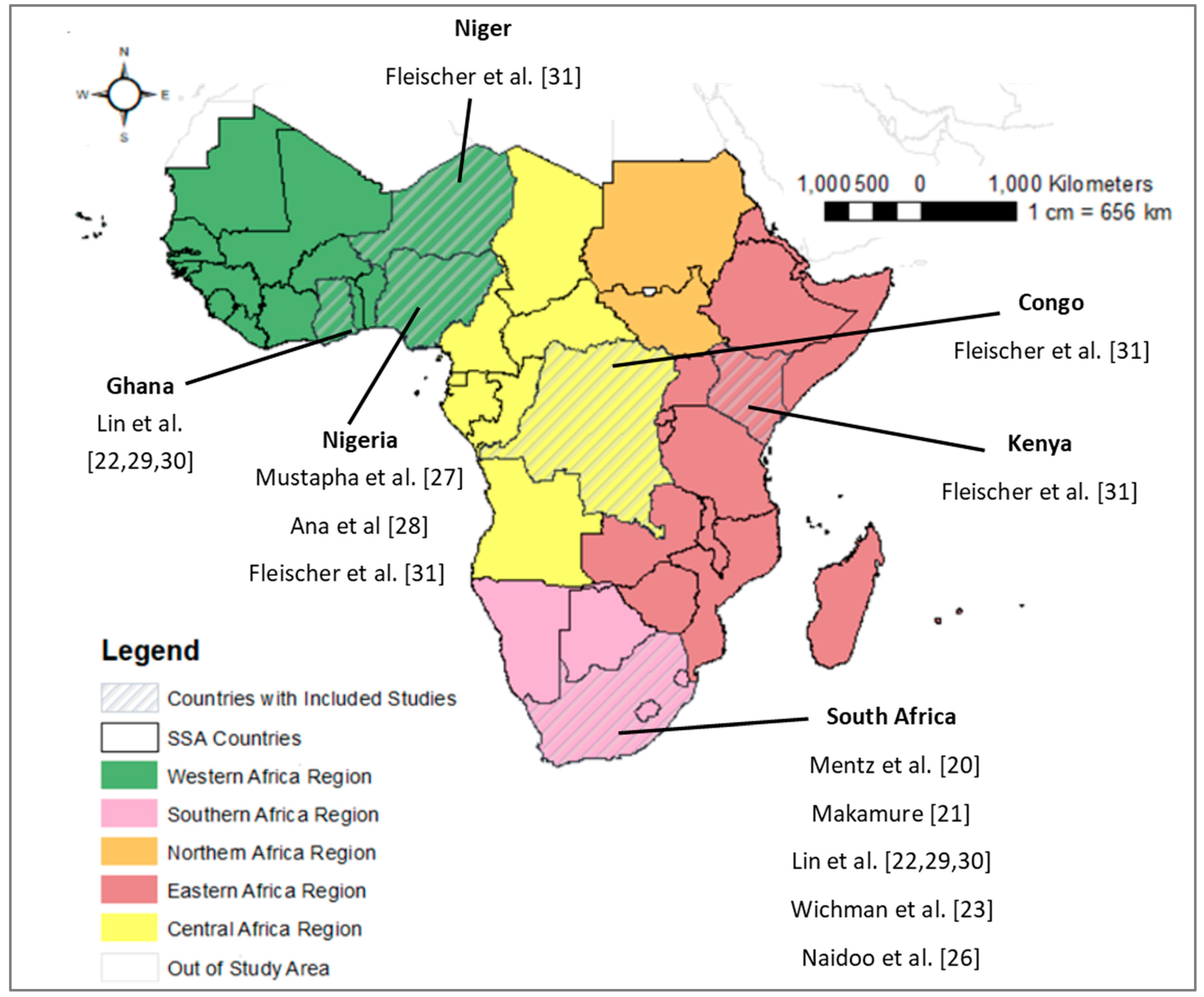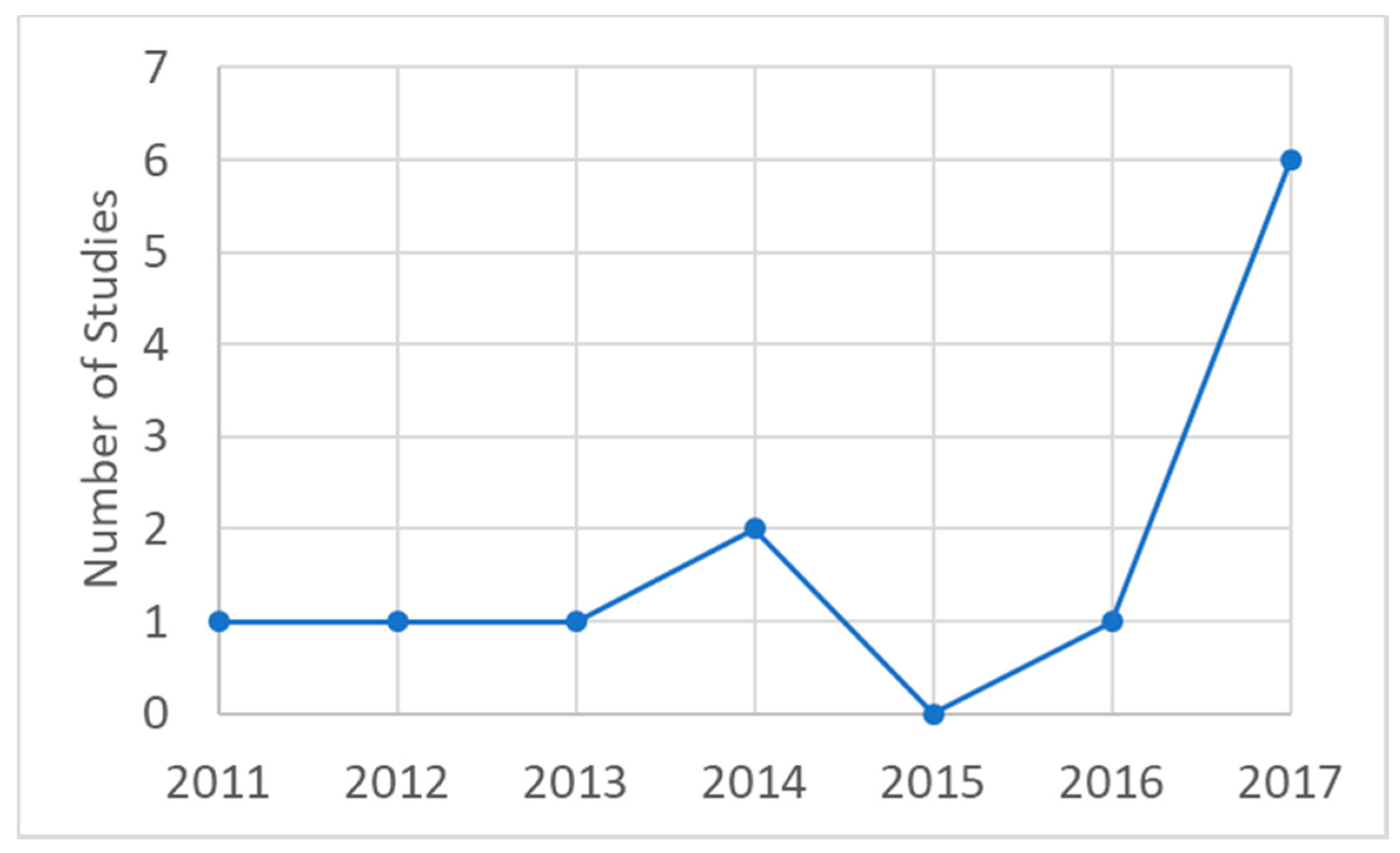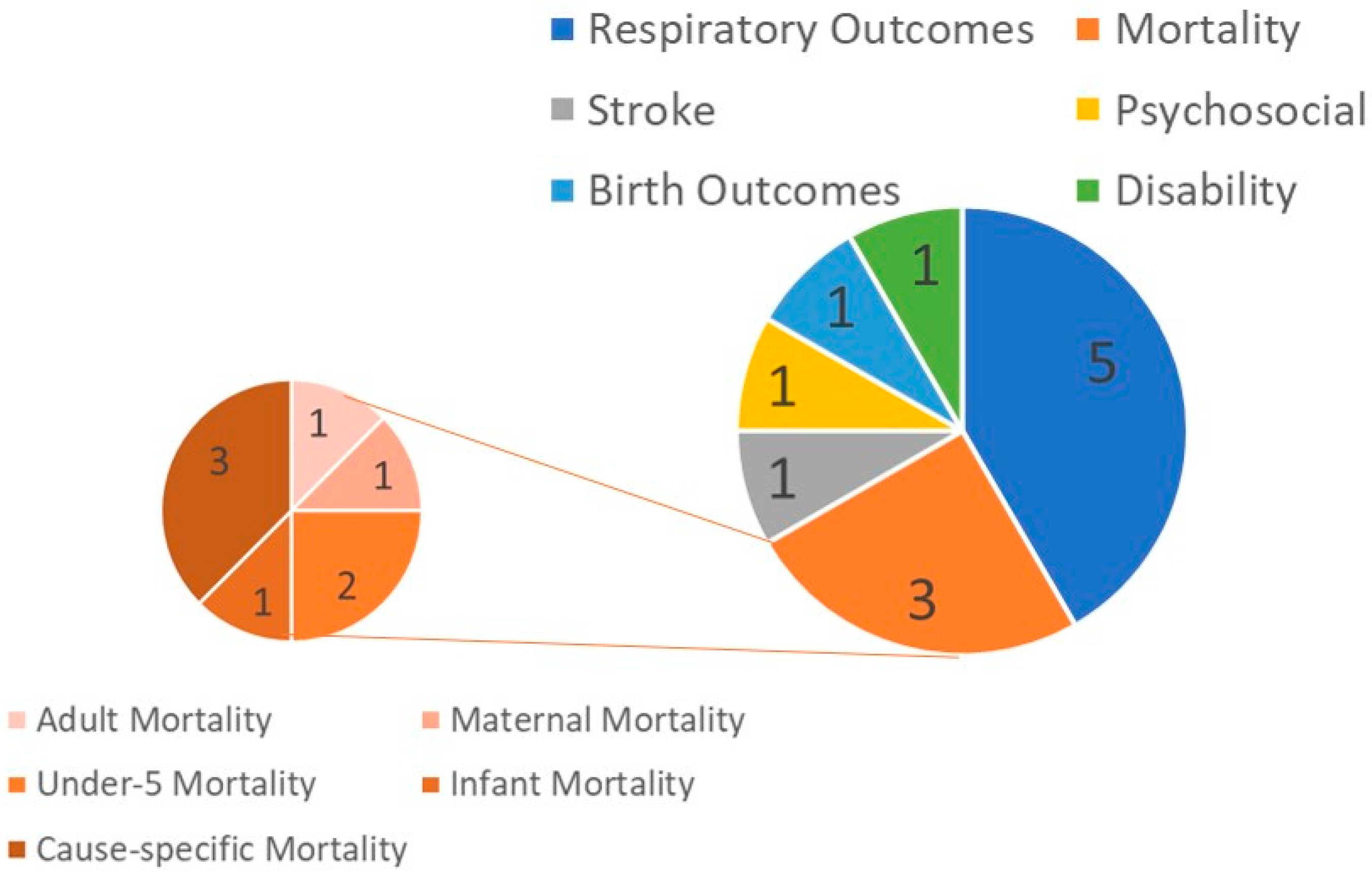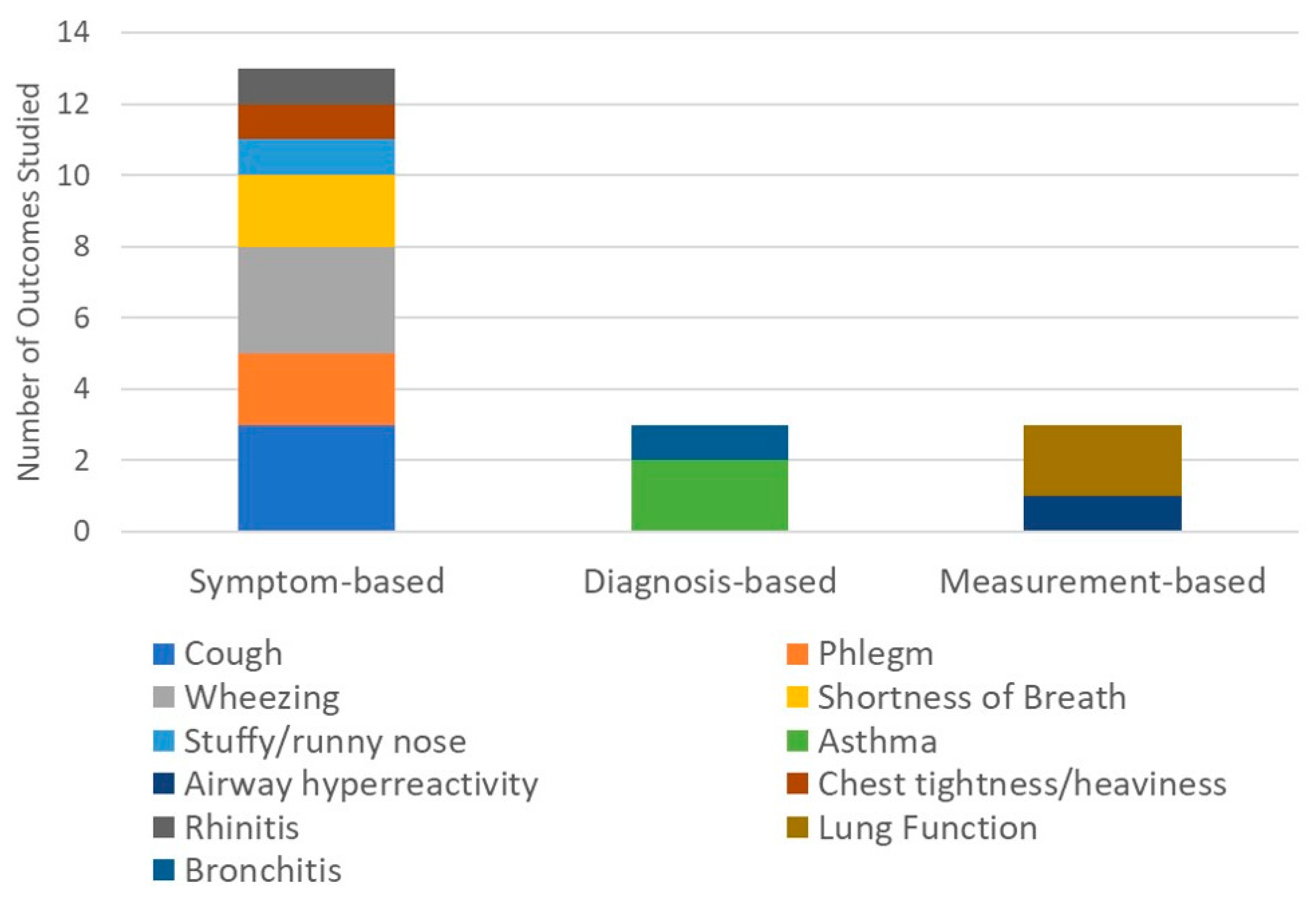A Narrative Review on the Human Health Effects of Ambient Air Pollution in Sub-Saharan Africa: An Urgent Need for Health Effects Studies
Abstract
1. Introduction
2. Methods
2.1. Systematic Review
2.2. Descriptive and Narrative Analysis
3. Results
4. Regional Patterns of Studies
5. Summary of Study Outcomes
6. Acute Health Effects Studies
6.1. Prospective Studies
6.2. Cross-Sectional Studies
7. Chronic Health Effects Studies
8. Discussion
8.1. Gaps in Ambient Air Pollution Monitoring and Exposure Estimation
8.2. Health Outcome Gaps
8.3. Data Analysis Gaps
8.4. Geographic Gaps in AAP Epidemiology Studies
8.5. Limitations and Strengths
9. Conclusions
Supplementary Materials
Acknowledgments
Author Contributions
Conflicts of Interest
References
- Landrigan, P.J.; Fuller, R.; Acosta, N.J.R.; Adeyi, O.; Arnold, R.; Basu, N.; Baldé, A.B.; Bertollini, R.; Bose-O’Reilly, S.; Boufford, J.I.; et al. The Lancet Commission on pollution and health. Lancet 2017. [Google Scholar] [CrossRef]
- WHO. Ambient (Outdoor) Air Quality and Health. Available online: http://www.who.int/mediacentre/factsheets/fs313/en/ (accessed on 11 December 2017).
- Amegah, A.K.; Agyei-Mensah, S. Urban air pollution in Sub-Saharan Africa: Time for action. Environ. Pollut. 2017, 220, 738–743. [Google Scholar] [CrossRef] [PubMed]
- Cohen, A.J.; Brauer, M.; Burnett, R.; Anderson, H.R.; Frostad, J.; Estep, K.; Balakrishnan, K.; Brunekreef, B.; Dandona, L.; Dandona, R.; et al. Estimates and 25-year trends of the global burden of disease attributable to ambient air pollution: An analysis of data from the Global Burden of Diseases Study 2015. Lancet 2017, 389, 1907–1918. [Google Scholar] [CrossRef]
- Shah, A.S.; Langrish, J.P.; Nair, H.; McAllister, D.A.; Hunter, A.L.; Donaldson, K.; Newby, D.E.; Mills, N.L. Global association of air pollution and heart failure: A systematic review and meta-analysis. Lancet 2013, 382, 1039–1048. [Google Scholar] [CrossRef]
- Zhao, R.; Chen, S.; Wang, W.; Huang, J.; Wang, K.; Liu, L.; Wei, S. The impact of short-term exposure to air pollutants on the onset of out-of-hospital cardiac arrest: A systematic review and meta-analysis. Int. J. Cardiol. 2017, 226, 110–117. [Google Scholar] [CrossRef] [PubMed]
- Cai, Y.; Zhang, B.; Ke, W.; Feng, B.; Lin, H.; Xiao, J.; Zeng, W.; Li, X.; Tao, J.; Yang, Z.; et al. Associations of Short-Term and Long-Term Exposure to Ambient Air Pollutants With HypertensionNovelty and Significance: A Systematic Review and Meta-Analysis. Hypertension 2016, 68, 62–70. [Google Scholar] [CrossRef] [PubMed]
- Nhung, N.T.T.; Amini, H.; Schindler, C.; Kutlar Joss, M.; Dien, T.M.; Probst-Hensch, N.; Perez, L.; Künzli, N. Short-term association between ambient air pollution and pneumonia in children: A systematic review and meta-analysis of time-series and case-crossover studies. Environ. Pollut. 2017, 230, 1000–1008. [Google Scholar] [CrossRef] [PubMed]
- Zheng, X.; Ding, H.; Jiang, L.; Chen, S.; Zheng, J.; Qiu, M.; Zhou, Y.; Chen, Q.; Guan, W. Association between Air Pollutants and Asthma Emergency Room Visits and Hospital Admissions in Time Series Studies: A Systematic Review and Meta-Analysis. PLoS ONE 2015, 10, e0138146. [Google Scholar] [CrossRef] [PubMed]
- World Bank. Data for Sub-Saharan Africa, Gabon, Ghana, Nigeria, South Africa. Available online: https://data.worldbank.org/?locations=ZG-GA-GH-NG-ZA (accessed on 20 December 2017).
- Ekpenyong, C.E.; Ettebong, E.O.; Akpan, E.E.; Samson, T.K.; Daniel, N.E. Urban city transportation mode and respiratory health effect of air pollution: A cross-sectional study among transit and non-transit workers in Nigeria. BMJ Open 2012, 2, e001253. [Google Scholar] [CrossRef] [PubMed]
- Agodokpessi, G.; Adjobimey, M.; Hinson, V.; Fayomi, B.; Gninafon, M. Air pollution and respiratory disease in a tropical urban setting in Cotonou, Benin. Med. Trop. Rev. Corps Sante Colon. 2011, 71, 41–44. [Google Scholar]
- Fourn, L.; Fayomi, E.B. Air pollution in urban area in Cotonou and Lokossa, Benin. Bull. Soc. Pathol. Exot. 2006, 99, 264–268. [Google Scholar] [PubMed]
- Ezejimofor, M.C.; Uthman, O.A.; Maduka, O.; Ezeabasili, A.C.; Onwuchekwa, A.C.; Ezejimofor, B.C.; Asuquo, E.; Chen, Y.-F.; Stranges, S.; Kandala, N.-B. The Burden of Hypertension in an Oil- and Gas-Polluted Environment: A Comparative Cross-Sectional Study. Am. J. Hypertens. 2016, 29, 925–933. [Google Scholar] [CrossRef] [PubMed]
- Shirinde, J.; Wichmann, J.; Voyi, K. Association between wheeze and selected air pollution sources in an air pollution priority area in South Africa: A cross-sectional study. Environ. Health 2014, 13, 32. [Google Scholar] [CrossRef] [PubMed]
- Shirinde, J.; Wichmann, J.; Voyi, K. Allergic rhinitis, rhinoconjunctivitis and hayfever symptoms among children are associated with frequency of truck traffic near residences: A cross sectional study. Environ. Health 2015, 14. [Google Scholar] [CrossRef] [PubMed]
- Brunekreef, B.; Stewart, A.W.; Anderson, H.R.; Lai, C.K.W.; Strachan, D.P.; Pearce, N. Self-Reported Truck Traffic on the Street of Residence and Symptoms of Asthma and Allergic Disease: A Global Relationship in ISAAC Phase 3. Environ. Health Perspect. 2009, 117, 1791–1798. [Google Scholar] [CrossRef] [PubMed]
- Amegah, A.K.; Jaakkola, J.J.K. Work as a street vendor, associated traffic-related air pollution exposures and risk of adverse pregnancy outcomes in Accra, Ghana. Int. J. Hyg. Environ. Health 2014, 217, 354–362. [Google Scholar] [CrossRef] [PubMed]
- White, N.; teWaterNaude, J.; van der Walt, A.; Ravenscroft, G.; Roberts, W.; Ehrlich, R. Meteorologically estimated exposure but not distance predicts asthma symptoms in schoolchildren in the environs of a petrochemical refinery: A cross-sectional study. Environ. Health 2009, 8, 45. [Google Scholar] [CrossRef] [PubMed]
- Mentz, G.; Robins, T.G.; Batterman, S.; Naidoo, R.N. Acute respiratory symptoms associated with short term fluctuations in ambient pollutants among schoolchildren in Durban, South Africa. Environ. Pollut. Bark. Essex 1987 2018, 233, 529–539. [Google Scholar] [CrossRef] [PubMed]
- Makamure, M.; Reddy, P.; Chuturgoon, A.; Naidoo, R.; Mentz, G.; Batterman, S.; Robins, T. Interaction between ambient pollutant exposure, CD14 (-159) polymorphism and respiratory outcomes among children in Kwazulu-Natal, Durban. Hum. Exp. Toxicol. 2017, 36, 238–246. [Google Scholar] [CrossRef] [PubMed]
- Lin, H.; Guo, Y.; Di, Q.; Zheng, Y.; Kowal, P.; Xiao, J.; Liu, T.; Li, X.; Zeng, W.; Howard, S.W.; et al. Ambient PM2.5 and Stroke: Effect Modifiers and Population Attributable Risk in Six Low- and Middle-Income Countries. Stroke 2017, 48, 1191–1197. [Google Scholar] [CrossRef] [PubMed]
- Wichmann, J.; Voyi, K. Ambient Air Pollution Exposure and Respiratory, Cardiovascular and Cerebrovascular Mortality in Cape Town, South Africa: 2001–2006. Int. J. Environ. Res. Public Health 2012, 9, 3978–4016. [Google Scholar] [CrossRef] [PubMed]
- Aliyu, A.J.; Ismail, N.W. The effects of air pollution on human mortality: Does gender difference matter in African countries? Environ. Sci. Pollut. Res. Int. 2016, 23, 21288–21298. [Google Scholar] [CrossRef] [PubMed]
- Owili, P.; Lien, W.-H.; Muga, M.; Lin, T.-H. The Associations between Types of Ambient PM2.5 and Under-Five and Maternal Mortality in Africa. Int. J. Environ. Res. Public Health 2017, 14, 359. [Google Scholar] [CrossRef] [PubMed]
- Naidoo, R.N.; Robins, T.G.; Batterman, S.; Mentz, G.; Jack, C. Ambient pollution and respiratory outcomes among schoolchildren in Durban, South Africa. S. Afr. J. Child Health 2013, 7, 127. [Google Scholar] [CrossRef] [PubMed]
- Mustapha, B.A.; Blangiardo, M.; Briggs, D.J.; Hansell, A.L. Traffic Air Pollution and Other Risk Factors for Respiratory Illness in Schoolchildren in the Niger-Delta Region of Nigeria. Environ. Health Perspect. 2011, 119, 1478–1482. [Google Scholar] [CrossRef] [PubMed]
- Ana, G.R.E.E.; Odeshi, T.A.; Sridhar, M.K.C.; Ige, M.O. Outdoor respirable particulate matter and the lung function status of residents of selected communities in Ibadan, Nigeria. Perspect. Public Health 2014, 134, 169–175. [Google Scholar] [CrossRef] [PubMed]
- Lin, H.; Guo, Y.; Kowal, P.; Airhihenbuwa, C.O.; Di, Q.; Zheng, Y.; Zhao, X.; Vaughn, M.G.; Howard, S.; Schootman, M.; et al. Exposure to air pollution and tobacco smoking and their combined effects on depression in six low- and middle-income countries. Br. J. Psychiatry 2017, 211, 157–162. [Google Scholar] [CrossRef] [PubMed]
- Lin, H.; Guo, Y.; Zheng, Y.; Zhao, X.; Cao, Z.; Rigdon, S.E.; Xian, H.; Li, X.; Liu, T.; Xiao, J.; et al. Exposure to ambient PM2.5 associated with overall and domain-specific disability among adults in six low- and middle-income countries. Environ. Int. 2017, 104, 69–75. [Google Scholar] [CrossRef] [PubMed]
- Fleischer, N.L.; Merialdi, M.; van Donkelaar, A.; Vadillo-Ortega, F.; Martin, R.V.; Betran, A.P.; Souza, J.P. Outdoor air pollution, preterm birth, and low birth weight: Analysis of the world health organization global survey on maternal and perinatal health. Environ. Health Perspect. 2014, 122, 425–430. [Google Scholar] [CrossRef] [PubMed]
- South Coast Air Quality Management District. Air Quality Sensor Summary Reports. Available online: http://www.aqmd.gov/aq-spec/evaluations/summary/ (accessed on 21 December 2017).
- Moodley, K.G.; Singh, S.; Govender, S. Passive monitoring of nitrogen dioxide in urban air: A case study of Durban metropolis, South Africa. J. Environ. Manag. 2011, 92, 2145–2150. [Google Scholar] [CrossRef] [PubMed]
- Olaniyan, T.; Jeebhay, M.; Röösli, M.; Naidoo, R.; Baatjies, R.; Künzil, N.; Tsai, M.; Davey, M.; de Hoogh, K.; Berman, D.; et al. A prospective cohort study on ambient air pollution and respiratory morbidities including childhood asthma in adolescents from the western Cape Province: Study protocol. BMC Public Health 2017, 17. [Google Scholar] [CrossRef] [PubMed]
- Rooney, M.S.; Arku, R.E.; Dionisio, K.L.; Paciorek, C.; Friedman, A.B.; Carmichael, H.; Zhou, Z.; Hughes, A.F.; Vallarino, J.; Agyei-Mensah, S.; et al. Spatial and temporal patterns of particulate matter sources and pollution in four communities in Accra, Ghana. Sci. Total Environ. 2012, 435–436, 107–114. [Google Scholar] [CrossRef] [PubMed]
- Dionisio, K.L.; Rooney, M.S.; Arku, R.E.; Friedman, A.B.; Hughes, A.F.; Vallarino, J.; Agyei-Mensah, S.; Spengler, J.D.; Ezzati, M. Within-Neighborhood Patterns and Sources of Particle Pollution: Mobile Monitoring and Geographic Information System Analysis in Four Communities in Accra, Ghana. Environ. Health Perspect. 2010, 118, 607–613. [Google Scholar] [CrossRef] [PubMed]
- Schwander, S.; Okello, C.D.; Freers, J.; Chow, J.C.; Watson, J.G.; Corry, M.; Meng, Q. Ambient Particulate Matter Air Pollution in Mpererwe District, Kampala, Uganda: A Pilot Study. J. Environ. Public Health 2014, 2014, 1–7. [Google Scholar] [CrossRef] [PubMed]
- De Sario, M.; Katsouyanni, K.; Michelozzi, P. Climate change, extreme weather events, air pollution and respiratory health in Europe. Eur. Respir. J. 2013, 42, 826–843. [Google Scholar] [CrossRef] [PubMed]




© 2018 by the authors. Licensee MDPI, Basel, Switzerland. This article is an open access article distributed under the terms and conditions of the Creative Commons Attribution (CC BY) license (http://creativecommons.org/licenses/by/4.0/).
Share and Cite
Coker, E.; Kizito, S. A Narrative Review on the Human Health Effects of Ambient Air Pollution in Sub-Saharan Africa: An Urgent Need for Health Effects Studies. Int. J. Environ. Res. Public Health 2018, 15, 427. https://doi.org/10.3390/ijerph15030427
Coker E, Kizito S. A Narrative Review on the Human Health Effects of Ambient Air Pollution in Sub-Saharan Africa: An Urgent Need for Health Effects Studies. International Journal of Environmental Research and Public Health. 2018; 15(3):427. https://doi.org/10.3390/ijerph15030427
Chicago/Turabian StyleCoker, Eric, and Samuel Kizito. 2018. "A Narrative Review on the Human Health Effects of Ambient Air Pollution in Sub-Saharan Africa: An Urgent Need for Health Effects Studies" International Journal of Environmental Research and Public Health 15, no. 3: 427. https://doi.org/10.3390/ijerph15030427
APA StyleCoker, E., & Kizito, S. (2018). A Narrative Review on the Human Health Effects of Ambient Air Pollution in Sub-Saharan Africa: An Urgent Need for Health Effects Studies. International Journal of Environmental Research and Public Health, 15(3), 427. https://doi.org/10.3390/ijerph15030427



